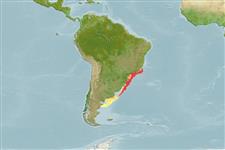Environment: milieu / climate zone / depth range / distribution range
Ökologie
seewasser demersal; tiefenbereich 15 - 300 m (Ref. 57919), usually 100 - 300 m (Ref. 57919). Tropical; 21°S - 44°S, 65°W - 40°W
Southwest Atlantic: Rio de Janeiro to the coast of Santa Catarina, Brazil (Ref. 27569); range extended to Argentina. Citations off Uruguay are probably misidentifications of Pseudopercis semifasciata (Ref. 57919).
Size / Gewicht / Alter
Maturity: Lm ? range ? - ? cm
Max length : 120 cm TL Männchen/unbestimmt; (Ref. 27569); common length : 40.0 cm TL Männchen/unbestimmt; (Ref. 6077); max. veröff. Gewicht: 20.2 kg (Ref. 40637)
Rückenflossenstacheln (insgesamt) : 7; Rückenflossenweichstrahlen (insgesamt) : 26 - 28; Afterflossenstacheln: 1 - 2; Afterflossenweichstrahlen: 24 - 27.
Inhabits deeper waters of the continental shelf (Ref. 27569). Also sandy, rubble and rocky bottoms and shallow rocky reef (Ref. 57919).
Life cycle and mating behavior
Maturities | Fortpflanzung | Spawnings | Egg(s) | Fecundities | Larven
Rosa, I.L. and R.S. Rosa, 1997. Systematic revision of the South American species of Pinguipedidae (Teleostei, Trachinoidei). Revta Bras. Zool. 14(4):845-865. (Ref. 27569)
IUCN Rote Liste Status (Ref. 130435)
Bedrohung für Menschen
Harmless
Nutzung durch Menschen
Fischereien: kommerziell; Sportfisch: ja
Tools
Zusatzinformationen
Download XML
Internet Quellen
Estimates based on models
Preferred temperature (Ref.
123201): 14.5 - 19.8, mean 17.4 °C (based on 36 cells).
Phylogenetic diversity index (Ref.
82804): PD
50 = 0.7500 [Uniqueness, from 0.5 = low to 2.0 = high].
Bayesian length-weight: a=0.00955 (0.00708 - 0.01289), b=3.01 (2.93 - 3.09), in cm total length, based on LWR estimates for this species (Ref.
93245).
Trophic level (Ref.
69278): 3.9 ±0.5 se; based on size and trophs of closest relatives
Widerstandsfähigkeit (Ref.
120179): sehr niedrig, Verdopplung der Population dauert mehr als 14 Jahre. (Preliminary K or Fecundity.).
Fishing Vulnerability (Ref.
59153): High to very high vulnerability (72 of 100).
